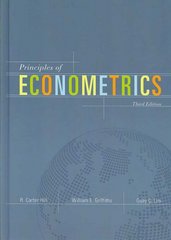Answered step by step
Verified Expert Solution
Question
1 Approved Answer
1 . The distinction between a change in demand and a change in quantity demanded. If the entire demand curve shifts ( e . g
The distinction between a change in demand and a change in quantity demanded. If the entire demand curve shifts eg more would be purchased at any given price that is a change in demand. If you change the price of Good X and the quantity demanded for Good X changes, that is a change in quantity demanded, NOT a change in demand. This point is often misstated by noneconomists eg Investopedia gets a lot of its economics definitions wrong To get a change in demand, you need something other than the price of that good to change. A change in income, a change in the price of a complementary good or a substitute good, or a change in tastes and preferences can shift a demand curve. That would be a change in demand. There are some videos in Module that dive deeper into this topic.
The distinction between positive economics and normative economics. If a statement is saying what is better or 'good, or 'bad, then it is a normative statement.
Know the importance of private property rights for a wellfunctioning economy.
'Scarcity' is not the same as 'shortage. Scarcity is what gives rise for the need for economics the study of the allocation of scarce resources If the amount of a good or service that society wants, when the price is zero, is greater than what is available, then that is a scarce good or service If we set a price above the marketclearing price, there would be a surplus, but the goodservice would still be scarce. If we set a price below the marketclearing price, there would be a shortage. 'Scarcity' is essentially what is happening at a price of zero. Charging a higher price is one way among many to allocate a scarce good. In the first discussion question, the surfable waves in Lunada Bay were a scarce resource, which were allocated based on the threat of violence. If the waves were not scarce, then there would be no competition for those waves.
Competition is inevitable if you have scarce goodsservicesresources However, having said that, a personfirm will usually prefer less competition to more competition.
Middlemen are important and provide their services in their own selfinterest. Note that we can also say that the sellers provide their goods and services in their own selfinterest, too.
When will people trade? Will people with identical tastes and preferences trade if they are given different starting bundles of goods?
What are transaction costs? Don't think of them as those extra charges you might have to pay to withdraw money out of an outofnetwork ATM machine. Instead, think of the nonmonetary costs involved in researching products, discovering prices, and consummating a dealpurchase
Consumer surplus is the difference between the maximum that you are willing to pay and what you actually pay.
Step by Step Solution
There are 3 Steps involved in it
Step: 1

Get Instant Access to Expert-Tailored Solutions
See step-by-step solutions with expert insights and AI powered tools for academic success
Step: 2

Step: 3

Ace Your Homework with AI
Get the answers you need in no time with our AI-driven, step-by-step assistance
Get Started


